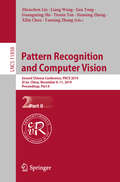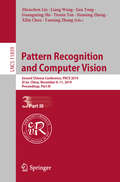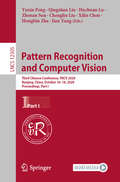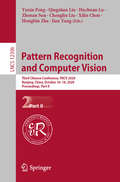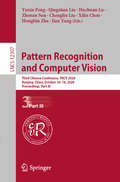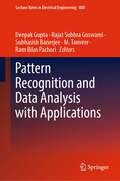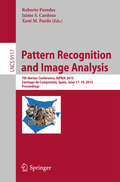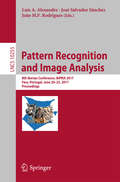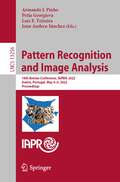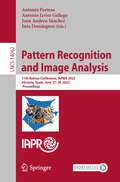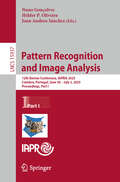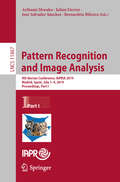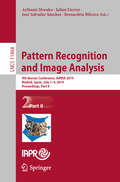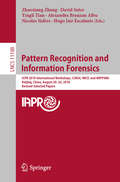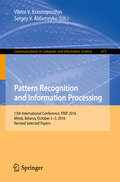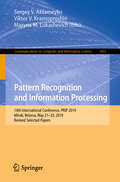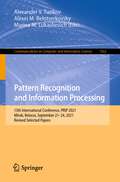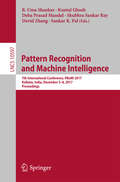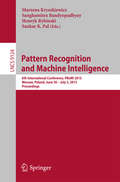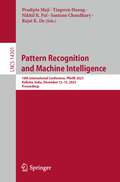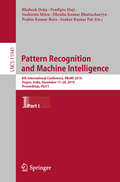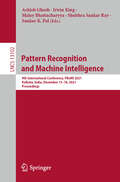- Table View
- List View
Pattern Recognition and Computer Vision: Second Chinese Conference, PRCV 2019, Xi’an, China, November 8–11, 2019, Proceedings, Part I (Lecture Notes in Computer Science #11857)
by Liang Wang Tieniu Tan Jian Yang Yanning Zhang Xilin Chen Nanning Zheng Zhouchen Lin Guangming ShiThe three-volume set LNCS 11857, 11858, and 11859 constitutes the refereed proceedings of the Second Chinese Conference on Pattern Recognition and Computer Vision, PRCV 2019, held in Xi’an, China, in November 2019. The 165 revised full papers presented were carefully reviewed and selected from 412 submissions. The papers have been organized in the following topical sections: Part I: Object Detection, Tracking and Recognition, Part II: Image/Video Processing and Analysis, Part III: Data Analysis and Optimization.
Pattern Recognition and Computer Vision: Second Chinese Conference, PRCV 2019, Xi’an, China, November 8–11, 2019, Proceedings, Part II (Lecture Notes in Computer Science #11858)
by Liang Wang Tieniu Tan Jian Yang Yanning Zhang Xilin Chen Nanning Zheng Zhouchen Lin Guangming ShiThe three-volume set LNCS 11857, 11858, and 11859 constitutes the refereed proceedings of the Second Chinese Conference on Pattern Recognition and Computer Vision, PRCV 2019, held in Xi’an, China, in November 2019. The 165 revised full papers presented were carefully reviewed and selected from 412 submissions. The papers have been organized in the following topical sections: Part I: Object Detection, Tracking and Recognition, Part II: Image/Video Processing and Analysis, Part III: Data Analysis and Optimization.
Pattern Recognition and Computer Vision: Second Chinese Conference, PRCV 2019, Xi’an, China, November 8–11, 2019, Proceedings, Part III (Lecture Notes in Computer Science #11859)
by Liang Wang Tieniu Tan Jian Yang Yanning Zhang Xilin Chen Nanning Zheng Zhouchen Lin Guangming ShiThe three-volume set LNCS 11857, 11858, and 11859 constitutes the refereed proceedings of the Second Chinese Conference on Pattern Recognition and Computer Vision, PRCV 2019, held in Xi’an, China, in November 2019. The 165 revised full papers presented were carefully reviewed and selected from 412 submissions. The papers have been organized in the following topical sections: Part I: Object Detection, Tracking and Recognition, Part II: Image/Video Processing and Analysis, Part III: Data Analysis and Optimization.
Pattern Recognition and Computer Vision: Third Chinese Conference, PRCV 2020, Nanjing, China, October 16–18, 2020, Proceedings, Part I (Lecture Notes in Computer Science #12305)
by Jian Yang Qingshan Liu Zhenan Sun Xilin Chen Huchuan Lu Yuxin Peng Hongbin Zha Chenglin LiuThe three-volume set LNCS 12305, 12306, and 12307 constitutes the refereed proceedings of the Third Chinese Conference on Pattern Recognition and Computer Vision, PRCV 2020, held virtually in Nanjing, China, in October 2020. The 158 full papers presented were carefully reviewed and selected from 402 submissions. The papers have been organized in the following topical sections: Part I: Computer Vision and Application, Part II: Pattern Recognition and Application, Part III: Machine Learning.
Pattern Recognition and Computer Vision: Third Chinese Conference, PRCV 2020, Nanjing, China, October 16–18, 2020, Proceedings, Part II (Lecture Notes in Computer Science #12306)
by Jian Yang Qingshan Liu Zhenan Sun Xilin Chen Huchuan Lu Yuxin Peng Hongbin Zha Chenglin LiuThe three-volume set LNCS 12305, 12306, and 12307 constitutes the refereed proceedings of the Third Chinese Conference on Pattern Recognition and Computer Vision, PRCV 2020, held virtually in Nanjing, China, in October 2020. The 158 full papers presented were carefully reviewed and selected from 402 submissions. The papers have been organized in the following topical sections: Part I: Computer Vision and Application, Part II: Pattern Recognition and Application, Part III: Machine Learning.
Pattern Recognition and Computer Vision: Third Chinese Conference, PRCV 2020, Nanjing, China, October 16–18, 2020, Proceedings, Part III (Lecture Notes in Computer Science #12307)
by Jian Yang Qingshan Liu Zhenan Sun Xilin Chen Huchuan Lu Yuxin Peng Hongbin Zha Chenglin LiuThe three-volume set LNCS 12305, 12306, and 12307 constitutes the refereed proceedings of the Third Chinese Conference on Pattern Recognition and Computer Vision, PRCV 2020, held virtually in Nanjing, China, in October 2020. The 158 full papers presented were carefully reviewed and selected from 402 submissions. The papers have been organized in the following topical sections: Part I: Computer Vision and Application, Part II: Pattern Recognition and Application, Part III: Machine Learning.
Pattern Recognition and Data Analysis with Applications (Lecture Notes in Electrical Engineering #888)
by M. Tanveer Ram Bilas Pachori Deepak Gupta Rajat Subhra Goswami Subhasish BanerjeeThis book covers latest advancements in the areas of machine learning, computer vision, pattern recognition, computational learning theory, big data analytics, network intelligence, signal processing and their applications in real world. The topics covered in machine learning involves feature extraction, variants of support vector machine (SVM), extreme learning machine (ELM), artificial neural network (ANN) and other areas in machine learning. The mathematical analysis of computer vision and pattern recognition involves the use of geometric techniques, scene understanding and modelling from video, 3D object recognition, localization and tracking, medical image analysis and so on. Computational learning theory involves different kinds of learning like incremental, online, reinforcement, manifold, multi-task, semi-supervised, etc. Further, it covers the real-time challenges involved while processing big data analytics and stream processing with the integration of smart data computing services and interconnectivity. Additionally, it covers the recent developments to network intelligence for analyzing the network information and thereby adapting the algorithms dynamically to improve the efficiency. In the last, it includes the progress in signal processing to process the normal and abnormal categories of real-world signals, for instance signals generated from IoT devices, smart systems, speech, videos, etc., and involves biomedical signal processing: electrocardiogram (ECG), electroencephalogram (EEG), magnetoencephalography (MEG) and electromyogram (EMG).
Pattern Recognition and Image Analysis
by Roberto Paredes Jaime S. Cardoso Xosé M. PardoThis book constitutes the proceedings of the 7th Iberian Conference on Pattern Recognition and Image Analysis, IbPRIA 2015, held in Santiage de Compostela, Spain, in June 2015. The 83 papers presented in this volume were carefully reviewed and selected from 141 submissions. They were organized in topical sections named: Pattern Recognition and Machine Learning; Computer Vision; Image and Signal Processing; Applications; Medical Image; Pattern Recognition and Machine Learning; Computer Vision; Image and Signal Processing; and Applications
Pattern Recognition and Image Analysis
by Luís A. Alexandre José Salvador Sánchez João M. RodriguesThis book constitutes the refereed proceedings of the 8th Iberian Conference on Pattern Recognition and Image Analysis, IbPRIA 2017, held in Faro, Portugal, in June 2017. The 60 regular papers presented in this volume were carefully reviewed and selected from 86 submissions. They are organized in topical sections named: Pattern Recognition and Machine Learning; Computer Vision; Image and Signal Processing; Medical Image; and Applications.
Pattern Recognition and Image Analysis: 10th Iberian Conference, IbPRIA 2022, Aveiro, Portugal, May 4–6, 2022, Proceedings (Lecture Notes in Computer Science #13256)
by Armando J. Pinho Petia Georgieva Luís F. Teixeira Joan Andreu SánchezThis book constitutes the refereed proceedings of the 10th Iberian Conference on Pattern Recognition and Image Analysis, IbPRIA 2022, held in Aveiro, Portugal, in May 2022. The 54 papers accepted for these proceedings were carefully reviewed and selected from 72 submissions. They deal with document analysis; medical image processing; biometrics; pattern recognition and machine learning; computer vision; and other applications.
Pattern Recognition and Image Analysis: 11th Iberian Conference, IbPRIA 2023, Alicante, Spain, June 27–30, 2023, Proceedings (Lecture Notes in Computer Science #14062)
by Joan Andreu Sánchez Antonio Pertusa Antonio Javier Gallego Inês DominguesThis book constitutes the refereed proceedings of the 11th Iberian Conference on Pattern Recognition and Image Analysis, IbPRIA 2023, held in Alicante, Spain, in June 27–30, 2023. The 56 papers accepted for these proceedings were carefully reviewed and selected from 86 submissions. They deal with Machine Learning, Document Analysis, Computer Vision, 3D Computer Vision, Computer Vision Applications, Medical Imaging & Applications, Machine Learning Applications.
Pattern Recognition and Image Analysis: 12th Iberian Conference, IbPRIA 2025, Coimbra, Portugal, June 30 – July 3, 2025, Proceedings, Part I (Lecture Notes in Computer Science #15937)
by Joan Andreu Sánchez Nuno Gonçalves Hélder P. OliveiraThe two volume set LNCS 15937 + 15938 constitutes the proceedings of the 12th Iberian Conference on Pattern Recognition and Image Analysis, IbPRIA 2025, which took place in Coimbra, Portugal, during June 30–July 3, 2025. The 67 full papers included in the proceedings were carefully reviewed and selected from 115 submissions. They were organized in topical sections as follows: Part I: Computer vision; faces, body, fingerprints and biometrics; machine and deep learning; explainability, bias and fairness in DL; Part II: Natural language processing; biomedical applications; and other applications.
Pattern Recognition and Image Analysis: 12th Iberian Conference, IbPRIA 2025, Coimbra, Portugal, June 30 – July 3, 2025, Proceedings, Part II (Lecture Notes in Computer Science #15938)
by Joan Andreu Sánchez Nuno Gonçalves Hélder P. OliveiraThe two volume set LNCS 15937 + 15938 constitutes the proceedings of the 12th Iberian Conference on Pattern Recognition and Image Analysis, IbPRIA 2025, which took place in Coimbra, Portugal, during June 30–July 3, 2025. The 67 full papers included in the proceedings were carefully reviewed and selected from 115 submissions. They were organized in topical sections as follows: Part I: Computer vision; faces, body, fingerprints and biometrics; machine and deep learning; explainability, bias and fairness in DL; Part II: Natural language processing; biomedical applications; and other applications.
Pattern Recognition and Image Analysis: 9th Iberian Conference, IbPRIA 2019, Madrid, Spain, July 1–4, 2019, Proceedings, Part I (Lecture Notes in Computer Science #11867)
by José Salvador Sánchez Bernardete Ribeiro Julian Fierrez Aythami MoralesThis 2-volume set constitutes the refereed proceedings of the 9th Iberian Conference on Pattern Recognition and Image Analysis, IbPRIA 2019, held in Madrid, Spain, in July 2019. The 99 papers in these volumes were carefully reviewed and selected from 137 submissions. They are organized in topical sections named: Part I: best ranked papers; machine learning; pattern recognition; image processing and representation.Part II: biometrics; handwriting and document analysis; other applications.
Pattern Recognition and Image Analysis: 9th Iberian Conference, IbPRIA 2019, Madrid, Spain, July 1–4, 2019, Proceedings, Part II (Lecture Notes in Computer Science #11868)
by José Salvador Sánchez Bernardete Ribeiro Julian Fierrez Aythami MoralesThis 2-volume set constitutes the refereed proceedings of the 9th Iberian Conference on Pattern Recognition and Image Analysis, IbPRIA 2019, held in Madrid, Spain, in July 2019. The 99 papers in these volumes were carefully reviewed and selected from 137 submissions. They are organized in topical sections named: Part I: best ranked papers; machine learning; pattern recognition; image processing and representation. Part II: biometrics; handwriting and document analysis; other applications.
Pattern Recognition and Information Forensics: ICPR 2018 International Workshops, CVAUI, IWCF, and MIPPSNA, Beijing, China, August 20-24, 2018, Revised Selected Papers (Lecture Notes in Computer Science #11188)
by Hugo Jair Escalante Zhaoxiang Zhang David Suter Yingli Tian Alexandra Branzan Albu Nicolas SidèreThis book constitutes the refereed post-conference proceedings of 3 workshops, held at the 24th International Conference on Pattern Recognition, Beijing, China, in August 2018: the Third International Workshop on Computer Vision for Analysis of Underwater Imagery, CVAUI 2018, the 7th International Workshop on Computational Forensics, IWCF 2018, and the International Workshop on Multimedia Information Processing for Personality and Social Networks Analysis, MIPPSNA 2018.The 16 full papers presented in this book were carefully reviewed and selected from 23 submissions. CVAUI Workshop: The analysis of underwater imagery imposes a series of unique challenges, which need to be tackled by the computer vision community in collaboration with biologists and ocean scientists. IWCF Workshop: With the advent of high-end technology, fraudulent efforts are on rise in many areas of our daily life, may it be fake paper documents, forgery in the digital domain or copyright infringement. In solving the related criminal cases use of pattern recognition (PR) principles is also gaining an important place because of their ability in successfully assisting the forensic experts to solve many of such cases. MIPPSNA Workshop: Its goal is to compile the latest research advances on the analysis of multimodal information for facing problems that are not visually obvious, this is, problems for which the sole visual analysis is insufficient to provide a satisfactory solution.
Pattern Recognition and Information Processing
by Viktor V. Krasnoproshin Sergey V. AblameykoThis book constitutes the refereed proceedings of the 13th International Conference on Pattern Recognition and Information Processing, PRIP 2016, held in Minsk, Belarus, in October 2016. The 18 revised full papers presented were carefully reviewed and selected from 72 submissions. The papers are organized in topical sections on summarizing lectures; pattern recognition and image analysis; information processing and applications.
Pattern Recognition and Information Processing: 14th International Conference, PRIP 2019, Minsk, Belarus, May 21–23, 2019, Revised Selected Papers (Communications in Computer and Information Science #1055)
by Viktor V. Krasnoproshin Sergey V. Ablameyko Maryna M. LukashevichThis book constitutes the refereed proceedings of the 14th International Conference on Pattern Recognition and Information Processing, PRIP 2019, held in Minsk, Belarus, in May 2019. The 25 revised full papers were carefully reviewed and selected from 120 submissions. The papers of this volume are organized in topical sections on pattern recognition and image analysis; information processing and applications.
Pattern Recognition and Information Processing: 15th International Conference, PRIP 2021, Minsk, Belarus, September 21–24, 2021, Revised Selected Papers (Communications in Computer and Information Science #1562)
by Alexander V. Tuzikov Alexei M. Belotserkovsky Marina M. LukashevichThis book constitutes the refereed proceedings of the 15th International Conference on Pattern Recognition and Information Processing, PRIP 2021, held in Minsk, Belarus, in September 2021. Due to the COVID-19 pandemic the conference was held online. The 17 revised full papers were carefully reviewed and selected from 90 submissions. The papers present a discussion on theoretical and applied aspects of computer vision, recognition of signals and images, the use of distributed resources, and high-performance systems.
Pattern Recognition and Machine Intelligence
by Sankar K. Pal David Zhang B. Uma Shankar Kuntal Ghosh Deba Prasad Mandal Shubhra Sankar RayThis book constitutes the refereed proceedings of the Second International Conference on Pattern Recognition and Machine Intelligence, PReMI 2007, held in Kolkata, India in December 2007. The papers are organized in topical sections on pattern recognition, image analysis, soft computing and applications, data mining and knowledge discovery, bioinformatics, signal and speech processing, document analysis and text mining, biometrics, and video analysis.
Pattern Recognition and Machine Intelligence
by Sanghamitra Bandyopadhyay Sankar K. Pal Marzena Kryszkiewicz Henryk RybinskiThis book constitutes the proceedings of the 6th International Conference on Pattern Recognition and Machine Intelligence, PReMI 2015, held in Warsaw, Poland, in June/July 2015. The total of 53 full papers and 1 short paper presented in this volume were carefully reviewed and selected from 90 submissions. They were organized in topical sections named: foundations of machine learning; image processing; image retrieval; image tracking; pattern recognition; data mining techniques for large scale data; fuzzy computing; rough sets; bioinformatics; and applications of artificial intelligence.
Pattern Recognition and Machine Intelligence: 10th International Conference, PReMI 2023, Kolkata, India, December 12–15, 2023, Proceedings (Lecture Notes in Computer Science #14301)
by Pradipta Maji Tingwen Huang Rajat K. De Santanu Chaudhury Nikhil R. PalThe LNCS volume constitutes the refereed proceedings of 10th International Conference, PReMI 2023, in Kolkata, India, in December 2023. The 91 full papers, presented together with abstracts of 6 keynote and invited talks, were carefully reviewed and selected from more than 300 submissions. The conference presents topics covering different aspects of pattern recognition and machine intelligence with real life state-of-the-art applications.
Pattern Recognition and Machine Intelligence: 8th International Conference, PReMI 2019, Tezpur, India, December 17-20, 2019, Proceedings, Part I (Lecture Notes in Computer Science #11941)
by Pradipta Maji Prabin Kumar Bora Sushmita Mitra Bhabesh Deka Dhruba Kumar Bhattacharyya Sankar Kumar PalThe two-volume set of LNCS 11941 and 11942 constitutes the refereed proceedings of the 8th International Conference on Pattern Recognition and Machine Intelligence, PReMI 2019, held in Tezpur, India, in December 2019. The 131 revised full papers presented were carefully reviewed and selected from 341 submissions. They are organized in topical sections named: Pattern Recognition; Machine Learning; Deep Learning; Soft and Evolutionary Computing; Image Processing; Medical Image Processing; Bioinformatics and Biomedical Signal Processing; Information Retrieval; Remote Sensing; Signal and Video Processing; and Smart and Intelligent Sensors.
Pattern Recognition and Machine Intelligence: 8th International Conference, PReMI 2019, Tezpur, India, December 17-20, 2019, Proceedings, Part II (Lecture Notes in Computer Science #11942)
by Pradipta Maji Prabin Kumar Bora Sushmita Mitra Bhabesh Deka Dhruba Kumar Bhattacharyya Sankar Kumar PalThe two-volume set of LNCS 11941 and 11942 constitutes the refereed proceedings of the 8th International Conference on Pattern Recognition and Machine Intelligence, PReMI 2019, held in Tezpur, India, in December 2019. The 131 revised full papers presented were carefully reviewed and selected from 341 submissions. They are organized in topical sections named: Pattern Recognition; Machine Learning; Deep Learning; Soft and Evolutionary Computing; Image Processing; Medical Image Processing; Bioinformatics and Biomedical Signal Processing; Information Retrieval; Remote Sensing; Signal and Video Processing; and Smart and Intelligent Sensors.
Pattern Recognition and Machine Intelligence: 9th International Conference, PReMI 2021, Kolkata, India, December 15–18, 2021, Proceedings (Lecture Notes in Computer Science #13102)
by Irwin King Sankar K. Pal Shubhra Sankar Ray Ashish Ghosh Malay BhattacharyyaThis book constitutes the refereed proceedings of the 9th International Conference on Pattern Recognition and Machine Intelligence, PReMI 2021, held in December 2021. Due to COVID-19 pandemic the conference was held virtually. The 62 full papers included in this book were carefully reviewed and selected from 215 submissions. They were organized in topical sections as follows: image processing; text, voice and video processing; bioinformatics; deep learning; medical image processing; theory and models; feature selection; biometrics and dermoscopy; facial image analysis; object and event detection; pattern recognition; machine learning applications.

